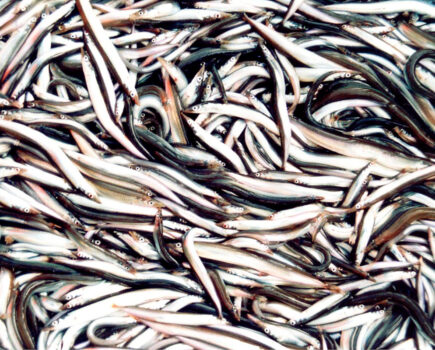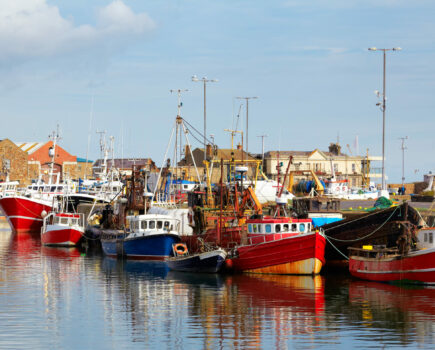The coast of west Wales is at once scenic, remote and self-contained. Most settlements have had a castle and fishing, and many still have, and while the castles are ruinous, the fishing is not, or not yet anyway, despite a national regulatory climate which seems oblivious to the needs and local economic importance of the inshore fleet.
John Worrall reports
Aberystwyth, halfway up the coast, is the biggest town, though small by national reckoning, with around 13,000 residents plus 10,000 students at the University of Wales. A busy resort in summer and learned all year – the University; the Welsh National Library; the country’s largest arts centre – it huddles between three hills and two beaches, and has its ruined castle and a west-facing Promenade that once saw it billed as the ‘Biarritz of Wales’.
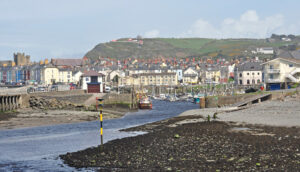
The tidal harbour at Aberystwyth has access for about half the tide.
Iron Age settlers, too early to appreciate that comparison, fortified Pen Dinas, a hill dominating the southern approach to the modern-day town, but the Normans opted for a central pitch for their first castle, and the Welsh stuck with it for a 13th-century replacement under Llywelyn the Great. The castle was captured in 1404 by Owain Glyndwr during the Welsh Revolt against Henry IV, but Henry won the rematch and the castle was finally reduced to rubble by Cromwell’s troops in the Civil War. Today only bits survive, but a lot of stone went to build local houses and so it’s an ill wind…
These days, Aberystwyth is indeed self-contained, those residents and students sustaining a thriving café culture and, allegedly, 50 pubs in the central square-mile. The harbour, originally at the confluence of two rivers – Ystwyth and Rheidol – now sits in the mouth of the latter, protected by groynes and walls. Redevelopment with inevitable waterside apartments reduced it by about a third and it now accommodates leisure craft and 10 registered fishing boats, seven of them U10s.
Shellfish leads the way
Fishing is mainly shellfish – scalloping and potting for lobsters and prawns (and that’s prawns as in big shrimps, rather than langoustines). There’s also whelking, but mainly done by bigger boats from away and local landings are modest. Herring was important in the Middle Ages and still figured in the 20th century.
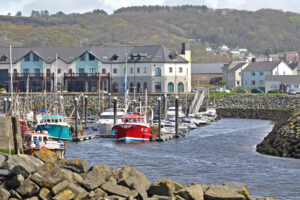
Harbour gentrification reduced it by a third but there is still room for a couple of visiting scallopers on the pontoons.
Aberystwyth skipper Robbie Gorman has done all these fisheries in his lifetime, with the exception of herring, and still does. He didn’t come from afishing family, but just wanted to do it when he left school in the 1960s, beginning by working for other fishermen before getting his own boat. Now he and his son John have three 12m vessels.
“When I started, it was all about lobsters,” he says, “but gradually scalloping and prawning developed. Crabs do feature – spiders in the summer and brown for more of the year – but not in massive amounts.
Everything is collected by vivier lorry, the scallops going to WM Shellfish in Holyhead and AM Seafoods of Fleetwood, and the crabs, lobsters and prawns to Castle Bay Seafoods at Haverfordwest in Pembrokeshire.”
John Gorman has also fished since he left school in 1996.
“I first worked on some of the larger wooden Devon crabbers in the Channel/North Sea and then on Devon steel shelter-decked crabbers working off northern Scotland. I also had a stint in Co Donegal before returning to fish from home 10 years later. I feel privileged to have gained experience from some top shellfishermen like Nick Bright, Rick Mitchelmore, Rob Simmonds and the Browse brothers.
“I got into scalloping about 10 years ago because it was a winter fishery where you could make a few quid. Now we are generally scalloping for half the year and potting for the other half.”
The three Gorman boats are the scalloper Joanna AB 177, and the potters Pen Dinas AB 77 and Quaker AB 7. Pots come from Gael Force and scallop gear from John Reid in Brixham.

Father and son Robbie and John Gorman have three 12m boats working from Aberystwyth (see slideshow)
Quaker is an interesting boat. Built oak-on-oak in 1980 by Yves Daniel in Paimpol, Brittany, she was one of two – the other was Falkland – destined for the Falkland Islands. Both were built on fishing boat lines but had large deck hatches and were to be used to transport sheep to fresh grazing around the archipelago. Falkland was shipped deck cargo but Quaker still hadn’t gone by the time the Falklands War began, and she was eventually sold to Jersey and used as a cargo boat until the late 1980s. Then someone in Guernsey rigged her for potting, after which she had spells in Weymouth and Exmouth before coming to Aberystwyth.
So pleased were Robbie and John with her that they had the Pen Dinas built on similar lines by C Toms & Son Ltd at Polruan in 2007. “I’m a wooden boat fan,” said Robbie.
“We’ve recently re-engined Quaker. The previous engine was still running well 17-18 years on – and we think it had been the first Daewoo (now Doosan) installation in this country. She’d had a Baudouin originally. But we thought that after that many years, she could do with a change. So we’ve fitted a Doosan L 136 160hp naturally aspirated.”
Quaker goes potting in summer with John and crew Kyle Bliss and Ryan Horton, while Joanna works the winter scallop fishery. Pen Dinas is also primarily a potter, working lobsters and sometimes prawns under skipper Paul Mansell and crew Tirion Davis and Vadim Pleshkov.
Scallop concerns
But while the potting is steady and the prawns can be good, the scallops continue to cause debate and acrimony between the industry and the regulators. Opportunity is presently restricted to an area about four miles by six, the edge of which lies about 20 miles south-west of Aberystwyth.
“The Welsh government aren’t opening more ground, even though they could,” says Robbie. “You know that just the other side of the imaginary line, you’re knee-deep in scallops. They keep saying that they will do something but nothing happens. That’s pretty hard. In fact, it’s a criminal waste.”
John agrees. “There was a consultation two years ago, and they agreed to go open more ground with new management measures, but nothing happened. It’s particularly frustrating for me because I’m in the prime of my life and I want it to be happening now, not when I’m old. We don’t have the option to go anywhere else, and so local boats and others from away tow round in that box, and with no permit system, it gets too intensively fished. If it was done right, there could be a really good Welsh scallop fishery with a rotating boxes system to give each box a long recovery time; it would be good for fishermen and the Welsh economy and a fishery to be proud of, if only the Welsh government would get on and make it happen.”
Prawns bring further diversity
Just along the quay at Aberystwyth are Dean Parry, with Three Sisters CA 44, and Dave Jones with Sturdy AB 129.
For them, prawns are the big number, a winter fishery best-suited to U10s because pots are set fairly close in, mainly within two miles, and winter weather on this coast is often too rough to go further, or anywhere at all.
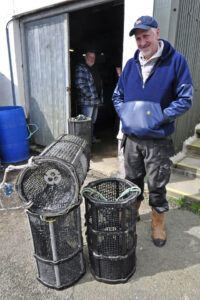
Dean also makes prawn pots…
“If you set lobster pots in winter, one storm can take them all away,” said Dean. He works Three Sisters with crew Laurence Burke on lobsters, prawns and whelks, while Dave works Sturdy single-handed on prawns, along with netting spider crabs in summer and dogfish whenever. Both work about 400 prawn pots of a design that can handle the weather – cylindrical, semi-buoyant and easily moved by surges, but in fleets of 30 restrained by leaded rope.
If the fishing is good, they might haul three times a week but perhaps weekly when things are quieter, and then ideally to coincide with the weekly vivier collection. Most go on by vivier to Spain.
“The live price is good,” says Dean. “Trawled prawns get a lot of fatalities but from our pots, the fatality rate is about 1%. So 99% will go on the lorry away from here.”
And what happens if the lorry has a breakdown?
“It has happened, but we’ve got space for two tonnes of seawater in the shed. So we stack them in fish boxes and put them in. As long as it’s not too warm, they’re okay, and if kept damp, they can last two to three hours out of water. At one time,we were shipping them ourselves in two kilo trays – about 180 prawns – down to Milford Haven, which is a two-hour run from here, and they were fine.
“The season runs from the end of September through to April or May. In the summer, the prawns move inshore to spawn, hiding in the kelp and in craggy areas where you can’t reach them. But they are the most important fishery on this coast for us little coastal boats.”
“The season runs from the end of September through to April or May. In the summer, the prawns move inshore to spawn, hiding in the kelp and in craggy areas where you can’t reach them”
Dave Jones, for his part, as well as prawn and lobster potting, has an indirect interest in whelking, in that he nets dogfish used for whelk bait.
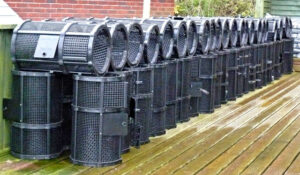
… and there are plenty more where they came from. (Photo: Dean Parry)
“I had a call yesterday from a whelk factory asking me for dogfish, because the crab have been so quiet, and they can’t get enough bait. And the fixed nets produce bass by-catch, and there are loads of bass about. I sometimes go lining for bass but I haven’t been netting or lining lately because I’ve been so busy with the spring prawn fishery.”
But Dean has a further angle on the prawns, in that he also makes the pots and now sells them around the country.
“Originally, I started making them for myself and perhaps to sell a few around here. Everyone had been buying French pots, but they became expensive and so I decided to make some. It was something to do in the winter when the weather was bad. But I started getting more orders and it’s helped keep my crew in a job. In fact, this winter has brought atrocious weather and for much of that time, there have been three of us making pots because I’ve taken on somebody else. And they’re about £20 cheaper than a French pot, and I think better.
“Every now and then if the fishing’s quiet and I’ve got 50, I’ll put them on Find-a-Fishing-Boat and they sell, usually within a day or two, and I deliver anywhere in the country. I didn’t think it would do as well as it has.”
Cardigan
Cardigan, 40 miles down the coast, is less than half the size of Aberystwyth, though its originally Norman castle is less ruinous. The town is also on a river – Teifi – but a couple of miles upstream, and the 10 registered U10s moor further down, at St Dogmaels or another mile further near the bar.
By the late 16th century, fishing, including herring, was the port’s main business and by 1815 there was much wider trade – the town had 314 ships, several times more than either Cardiff or Swansea – together with a lot of shipbuilding, and over 60 pubs.
But the bar – the sand bar, that is – was always troublesome and became more so, and with river silting, most trade except fishing had fallen away by the early 20th century.
Len Walters and his son Aaron work two U10s, the Glas y Dorlan CA 32 and Channel Fisher CA 33, from St Dogmaels, mostly each with a crew. The boats moor in the river just below the village.
Again it’s potting, in part anyway, here for lobster and brown crab the year round, and in the summer tangle netting for spiders.
“But we don’t land spiders of less than a kilo,” says Len. “Just the large males of 2-3 kilos. We also hand-line for bass and mackerel, and both boats scallop when the weather allows.”
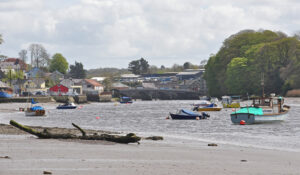
The river Teifi coming down from Cardigan bridge. Two hundred years ago, the town had over 300 ships, but the river silted and you wouldn’t get one of any size up that far now.
They are closer to the scallop box than Aberystwyth.
“From the bar, the edge is about three and a half miles although it’s four to where you can really start fishing. That’s okay for the big boats, but for U10s it’s sometimes murder because with the wind in the south or south-west, it can be fine inshore, but out there you’re being thrown all over the place and you can’t get your gear on the ground. Seven or eight years ago, we were allowed to fish right up to the shore, but we’ve lost that which is a big disadvantage.
“With bass, you can do well lining when the conditions are right. There are an awful lot of small fish around but there are some of good landable size.”
Most of the spiders go off on vivier lorries, eventually to Portugal, but the lobster and brown crab they process themselves and sell locally, at farmers’ markets and to restaurants.
“My wife, Mandy, does that. It all began because where we live, there is no infrastructure whatsoever, and so if we came back with a box of bass, what could we do with it? So she started selling that locally. But then the farmers’ market started here in the village and boomed, and it’s all gone from there really.”
Funding inequalities
But self-sufficiency in the bigger picture is also necessary, it seems, because, says Len, there is very little government assistance, not least in accessing EMFF.
“In England, there are EMFF 420 projects, but in Wales, only one fisherman has managed to get anything, a guy in Saundersfoot. And he only got it because the chap handling his application absolutely persevered and managed to get it through. But he said he wouldn’t do one again.
“In England, we see boats being rebuilt, new pots, gear, engines, but the Welsh government says we can’t have any of that. When you approach them, you are told that your project isn’t eligible.”
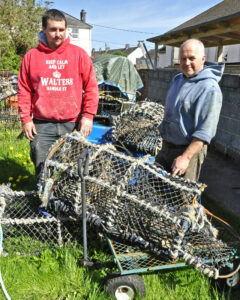
Len Walters and son Aaron each work a boat on potting and scalloping, along with a bit of netting and lining – and the occasional day spent mending pots in the sunshine.
(The Fisheries Business Development Advisors Scheme page of the Welsh government website– bit.ly/2rj9Rou – now says that as of February this year, the scheme is being reviewed and no new applications will be accepted until the review is finished.)
“We took evidence of engines being fitted in England, and they actually told us that England was acting illegally and you weren’t allowed to give grants for engines. I know of three boys who have now bought new engines. They’ve had no help. We have been completely shut off for some reason. All the way around Wales, there is no infrastructure whatsoever – no cranes, landing facilities; we’re landing catches manually.
“And then FLAG groups: we asked about ice machines and cool boxes, which would be a huge benefit to us. But we were told that we couldn’t have any tangible assets at the end of the programme. And so this money, supposedly for the fishing industry and fishing communities, has to be spent on nonsense projects, hasn’t it?”
None of which is helpful or encouraging.
But there is a further dimension to the Walters family fishing enterprise, which is more or less the final dimension in low-impact self-sufficiency, because Len and Aaron are among the few still licensed to net sea trout and salmon in the river Teifi. Len works with one other in a pair of coracles in the stretch above Cardigan, while Aaron seines in the lower reaches, in a season running from 1 April to 31 August, although salmon aren’t retained until 1 June. This is fishing to an old but dying tradition, in which they make their coracles, catch their fish and sell them direct, now through that farmers’ market.
But that is – and will be – another story.





